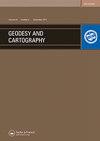Investigation of background noise in the GNSS position time series using spectral analysis – A case study of Nepal Himalaya
IF 2.1
Q3 REMOTE SENSING
引用次数: 1
Abstract
Position time series from permanent Global Navigation Satellite System (GNSS) stations are commonly used for estimating secular velocities of discrete points on the Earth’s surface. An understanding of background noise in the GNSS position time series is essential to obtain realistic estimates of velocity uncertainties. The current study focuses on the investigation of background noise in position time series obtained from thirteen permanent GNSS stations located in Nepal Himalaya using the spectral analysis method. The power spectrum of the GNSS position time series has been estimated using the Lomb–Scargle method. The iterative nonlinear Levenberg–Marquardt (LM) algorithm has been applied to estimate the spectral index of the power spectrum. The power spectrum can be described by white noise in the high frequency zone and power law noise in the lower frequency zone. The mean and the standard deviation of the estimated spectral indices are −1.46±0.14,−1.39±0.16 and −1.53± 0.07 for north, east and vertical components, respectively. On average, the power law noise extends up to a period of ca. 21 days. For a shorter period, i.e. less than ca. 21 days, the spectra are white. The spectral index corresponding to random walk noise (ca. –2) is obtained for a site located above the base of a seismogenic zone which can be due to the combined effect of tectonic and nontectonic factors rather than a spurious monumental motion. Overall, the usefulness of investigating the background noise in the GNSS position time series is discussed.利用频谱分析研究GNSS位置时间序列中的背景噪声-以尼泊尔喜马拉雅地区为例
本文章由计算机程序翻译,如有差异,请以英文原文为准。
求助全文
约1分钟内获得全文
求助全文
来源期刊

Geodesy and Cartography
REMOTE SENSING-
CiteScore
1.50
自引率
0.00%
发文量
0
审稿时长
15 weeks
期刊介绍:
THE JOURNAL IS DESIGNED FOR PUBLISHING PAPERS CONCERNING THE FOLLOWING FIELDS OF RESEARCH: •study, establishment and improvement of the geodesy and mapping technologies, •establishing and improving the geodetic networks, •theoretical and practical principles of developing standards for geodetic measurements, •mathematical treatment of the geodetic and photogrammetric measurements, •controlling and application of the permanent GPS stations, •study and measurements of Earth’s figure and parameters of the gravity field, •study and development the geoid models,
 求助内容:
求助内容: 应助结果提醒方式:
应助结果提醒方式:


